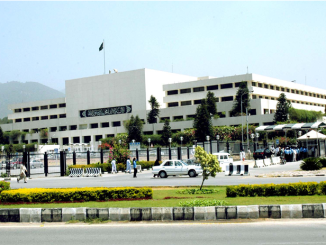
May 28th is a day of pride (Yom-e-Taqbeer) for Pakistan that placed it as a member of an exclusive club of less than ten states. 28 May, 1998 is the day when Pakistan’s nuclear tests readjusted the regional balance of power. The zealous celebrations of this day signify commendable efforts that Pakistan’s scientists placed into making Pakistan more secure. There is no doubt that nuclear deterrence is the most important strategic factor for the preservation of Pakistan’s national security.
Unlike what many nations think, Pakistan’s weapons are primarily “weapons of deterrence”, not prestige. Pakistan always supported the idea of peaceful uses of nuclear technology that began with its participation in the US Atoms for Peace initiative. There were three main events that made Pakistan’s reluctant entrance into the nuclear club a reality. First, India’s involvement in dismembering Pakistan’s Eastern Wing, India testing its nuclear weapons in 1974 and then the 11th May Indian tests. These events left Pakistan with no other option but to opt for nuclear weapons, keeping in mind the security situation of the region and its conventional arms weakness vis-à-vis India. It cannot be disputed that Pakistan was a reluctant entrant in the nuclear weapons game as no country can overlook its security concerns.
The event presented a unique look into the prevailing dynamics of nuclear deterrence and strategic stability within the contemporary South Asian security environment. It was the Indian tests that affected the balance of power and started an arms race in the region. It was such actions that forced Pakistan to go for nuclear weapons with the sole aim to maintain deterrence stability and a balance of power. It is pertinent to note here that since Pakistan acquired nuclear weapons capability, it has not indulged in any arms race with India. Consequently, Pakistan has always shown a restrained response to Indian aggression. It cannot be disputed that as India’s nuclear programme is for prestige and an attempt to reverse the global order and regional order. Furthermore, Pakistan’s efforts for acquiring such capability were purely security driven to counter Indian belligerence. This also is a right of self-defence as enshrined in Article 51 of the United Nations Charter.
After the tests conducted by Pakistan, it faced isolation at the international stage. There were abrupt views that the development of a nation depends on its political stability, foreign policy, economic stability and providing better resources to its civilians rather than opting for nuclear weapons. There is no doubt that these factors are important for the uplift of any nation and its stability. Nevertheless, nuclear strength was a significant milestone to be achieved where you have an arch nuclear rival in the neighbourhood, which is not only conventionally superior, but also hostile enough to launch military adventurism against you in the future.
The nuclear tests by Pakistan made it an unthinkable option for both countries in South Asia to opt for a full-scale war in the region. These tests led to the start of peace process in 1999. However, the Kargil event halted the process but it resumed again in 2004 by the name of composite dialogue. During this process, both countries agreed that the nuclear capability constituted a factor of stability in the region. Furthermore, Pakistan has offered a Strategic Restraint Regime (SRR) and many confidence building measures to India which have been turned down by the obnoxious neighbour.
The introduction of Cold Start Doctrine (CSD), also known as Pro Active Strategy, to conduct limited conventional operations under nuclear overhang has completely changed the scenario in the region. Therefore, in order to ensure the credibility of nuclear deterrence, Pakistan opted to induct Short Range Ballistic Missiles (SRBMs) as a part of its Full Spectrum Deterrence (FSD) posture. The FSD is not a quantitative shift but a qualitative response to address new the challenge posed by India’s CSD. SRBMs are the final strand in completion of deterrence and an effective defence mechanism. These Short-Range Low Yield weapon systems are meant to plug the perceived gaps that Indian planners seek to exploit, thereby, pouring cold water on Cold Start. Thus, Islamabad’s full spectrum deterrence has frustrated and upset Indian designs. Former Director General of Strategic Plans Division General Khalid Kidwai also stated that the development of FSD is to bring “every Indian target into Pakistan’s striking range” and acquire “appropriate weapons yield coverage and the numbers to deter the adversary’s pronounced policy of massive retaliation.”
Over the past two decades, whatever Pakistan achieved in nuclear field helped Pakistan in ensuring balance of power in the region. For instance, Pakistan introduced Babur III Submarine Launched Cruise Missile (Hatf VII) to counter Indian Ballistic Missile Defence (BMD) System, which, otherwise, can give India a false sense of security which can pave way to Indian military adventurism against Pakistan. Due to these Indian developments, India can also opt for a first strike or a decapitating nuclear strike against Pakistan. Pakistan also introduced Ababeel MIRV missile which is critical vis-à-vis India’s rapidly developing missile defence shield. Furthermore, Indian completion of the nuclear triad is also a case in point, because, if only one adversary acquires an assured second-strike capability, it destabilizes deterrence.
Once the international community turned a blind eye towards Indian nuclear test that eroded stability in South Asia, Pakistan had to act to ensure deterrence stability in the region. Likewise, Indian nuclear and military modernization including acquisition of BMD systems, MIRVing, cannisterization of missiles and nuclearization of Indian Ocean Region is ignored by the international community. This situates the onus of ensuring peace and stability on Pakistan once again. Pakistan will obviously stop at a point where it feels it has enough to deter India but whether the same applies to India is uncertain. Without nuclear weapons, Pakistan’s national security interests will always be in jeopardy and this is a lofty risk which Pakistan cannot take.
![]()




Be the first to comment